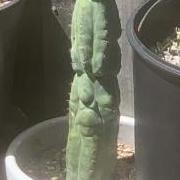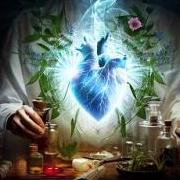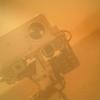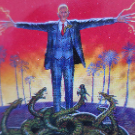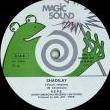Leaderboard
Popular Content
Showing content with the highest reputation since 16/03/24 in all areas
-
1 pointDoing lots of cuttings of this at the moment, if someone wants to grow it get in touch here. No WA/TAS. Tea has been prepared from the leaves, rich in antioxidants. Iresine herbstii (Amaranthaceae), traditionally called “cimora se˜ norita”, is used in black magic (De Feo, 2003) and in association with San Pedro for magic rituals (Friedberg, 1959; Dobkin De Rios, 1977; De Feo, 2003), to diagnose illness, and to take possession of another identity (Cruz-Sanchez, 1948). Its leaves are claimed, for external use, a skin depurative, whereas the aerial part decoction is known to be an antipyretic (De Feo, 2003). - anti-inflammatory, cytotoxic and apoptotic activities and antioxidant activity - affinity for the 5-HT1AR - affinity for 5-HT2C receptor and for D1 receptor (MeOH extract) - lower affinity for D1 and higher affinity for D2 receptors (Aq. extract) - presumable antagonist action on D1 and D2 receptors by Iresine (both extracts) Leaves: 2,5-Dimethoxy-6,7-(methylenedioxy)-isoflavone; acylated betacyanins Roots: oleanolic acid and its saponins. An alcoholic extract of the root showed the presence of amino acids, steroids, triterpenoids, alkaloids and coumarins. https://doi.org/10.1016/j.jep.2005.11.022 https://doi.org/10.1076/phbi.34.3.184.13212
-
1 pointI've been propagating this for a while now, but have no experience with consumption. How does it taste? Grows well from cutting, but not from seed, in my (limited) experience.
-
1 point
-
1 pointNow that spring is almost upon us I thought I’d share the method I use to germinate Acacia Phlebophylla seeds. It has taken a few years of trial and error but now I have it down pat. I’ve got it to 90%+ germination rate all in the first month of spring. It certainly isn’t the only method but it works for me and I thought sharing might encourage others to give it a try. I like to start the process early August (as it takes about 4 weeks for them to start germinating) to take full advantage of the spring/summer growing season. I use a razor blade and take a tiny nick off the hilum end of the seed, this is where the root will come through. Be careful not to take too much off you only need to get through outer coat. Once they are all scarified I then soak them for 24hrs in previously boiled but COLD water. Boiling water at this point will kill your seeds if using this method. After 24hrs and seeds have swelled up, I now put them in a plastic Chinese container between two sheets of damp paper towel (I like viva brand as it holds a lot more moisture than cheaper towel), all spaced out so they aren’t touching. I put the lid on and place them in the fridge. They will germinate in the fridge and throw out a tap root but it normally takes about four to six weeks for the first ones to start. Once they grow their little root (2 or 3mm, don’t let it get too long) I pick them out of the container and put the rest back in the fridge, checking them every few days. It normally takes a few weeks for them all to germinate once they’ve started. I then very carefully with a pair of tweezers peel off the outer coating of the seed and plant them in a seedling tray just under the soil with the root facing down. I put the seedling tray in the hothouse watering daily as seedling trays dry out quickly. Your little seedlings will be up in a few days. soil mix used is pretty simple, 3 parts Bunnings native potting mix to 1 part river sand, with a handful of soil from the base of one of your local acacias as a rhizobia inoculant mixed in to every seedling tray. They take a couple of months to get their first adult leaves but once they do they grow fairly quickly. I also then start fertilising them with swift grow (swiftgrow.com.au) every couple of weeks. Happy gardening
-
1 pointThe nutrients in that mix might be counter-productive for the purposes of germination. I had a batch of A. phlebophylla seedlings that I killed (wilting, shrivelling, and dying pretty much as you describe) because I accidentally fertilised them. Seeds in general, I reckon, are self-sufficient and have no need of additional nutrients. So I tend to avoid fertiliser at this stage, as a rule of thumb. For potting on, once established, native potting mix from Bunnings gives good results. Bunnings also sells coarse river sand for propagation, your best friend. Here's what Simmons recommends (scanned pages with info here) Seed growing mix: 3 parts washed or sterilised coarse river sand 1 part peat moss or aged crushed pine bark or 3 parts perlite 1 part peat moss Potting on mix: 3 parts coarse river sand 1 part peat moss or old milled bark 1 part loam or perlite or 2 parts sand 1 part peat 1 part gravel with old manure or compost added Cutting mixture: 3 parts coarse river sand 1 part peat moss or old crushed bark 1 part perlite or a soil-less mix 3 parts perlite 1 part peat moss
-
1 pointNeuroscience is not my strength, would you say that this difference is a possible reason for galantamine being effective and the other not, although both increase the ACh in the brain? I took 300ug of Huperizine A last night, this time before bed time, rather that after 4 hours of sleep, and all it did was to prevent me from sleeping. I though that perhaps it began to work at a slower pace than galantamine. I'm a bit disappointed as it is easily available and cheaper. I have suspended its use for now as I want to focus on one supplement at a time. The 50mg freebase was based on the journal article "Use of DMAE (2-dimethylaminoethanol) in the induction of lucid dreams" by W. Sergio. He claimed that after 2 weeks, the level built up and he was able to have lucid dreams of the WILD type in the mornings. I will most definitely focus on this substance again in due course as it may have helped with my everyday memory. I haven't as yet, but I soon will receive alpha GPC, 600mg. Apparently, it can also trigger lucidity by itself, according to the book "Advanced Lucid Dreaming - The Power of Supplements" and as you mention works very well with galantamine, I will will see if Huperizine can be made to work with it too. Some other things the book mentions include tiny doses of yohimbine and nicotine, although the latter is said to damage some receptors crucial for lucid dreaming. L-Dopa from mucuna pruriens is also recommended to better quality dreams. The book is rather old , so there is no mention of using huperizine or salvinorin A. Next plan of action is the alpha GPC, by itself, with galantamine and finally with huperizine, all after 4-5 hours of sleep. But first I will take P5P for a week to investigate if this form of vitamin B6 truly helps with dream recall. I'm interested in lucid dreams and etheric projection (astral projection on this plane). I've never had the latter, not even sure if it is a real thing or a type if lucid dream. Author links open overlay panel
-
1 pointGalantamine is interesting as it functions as both an AChE inhibitor and positive allosteric modulator of a7-nAChRs, I found it quite cognitively interesting but wasn't looking for lucid dreams. On the contrary, huperzine A seems more to be AChE/NMDARs. Your DMAE dose seems personally quite low but I can see there being challenges using it with sleep as some people find it activating. As the bitartrate 250mg-500mg may be more typical, eq, dimethylaminoethanol freebase ~186mg at the upper dose. Out of interest, have you explored something like CDP-choline as a cholinergic? It seems to have procognitive effects mediated by predominately a7-nAChR activation. More recently there's been interest in coupling AChE inhibition with CDP-choline or alpha-GPC for dementias and that seems to be an effective augmentation, so perhaps that could be possible to cautiously augment huperzine A with such, in theory. I have some Silene undulata 98% triterpenoid saponins extract from the SAB store, if you want a bit in an envelope no cost send me a PM. It didn't get as frothy as expected (presumptive test for saponins) but did form a lasting sort of foam to some extent.
-
1 point
-
1 pointThe Psychedelic Evangelist Brendan Borrell 21–26 minutes https://www.nytimes.com/2024/03/21/health/psychedelics-roland-griffiths-johns-hopkins.html Credit...Caitlin Teal Price A Johns Hopkins scientist was known for rigorous studies of psychedelics. Was he a true believer? Credit...Caitlin Teal Price March 21, 2024Updated 12:34 p.m. ET Before he died last year, Roland Griffiths was arguably the world’s most famous psychedelics researcher. Since 2006, his work has suggested that psilocybin, found in magic mushrooms, can induce mystical experiences, and that those experiences, in turn, can help treat anxiety, depression, addiction and the terror of death. Dr. Griffiths and his colleagues at Johns Hopkins University received widespread recognition among scientists and the popular press, helping to pull the psychedelic field from the deep backwater of the 1960s hippie movement. This second wave of research on the hallucinogenic compounds bolstered political campaigns to decriminalize them and spurred biotech investment. Dr. Griffiths was known to friends and colleagues as an analytical thinker and a religious agnostic, and he warned fellow researchers against hype. But he also saw psychedelics as more than mere medicines: Understanding them could be “critical to the survival of the human species,” he said in one talk. Late in life, he admitted to taking psychedelics himself, and said he wanted science to help unlock their transformative power for humanity. Perhaps unsurprisingly, he held a vaunted, even prophetic role among psychonauts, the growing community of psychedelic believers who want to bring the drugs into mainstream society. For years, critics have denounced the outsize financial and philosophical influence of these advocates on the insular research field. And some researchers have quietly questioned whether Dr. Griffiths, in his focus on the mystical realm, made some of the same mistakes that doomed the previous era of psychedelic science. Now, one of his longtime collaborators is airing a more forceful critique. “Dr. Griffiths has run his psychedelic studies more like a ‘new-age’ retreat center, for lack of a better term, than a clinical research laboratory,” reads an ethics complaint filed to Johns Hopkins last fall by Matthew Johnson, who worked with Dr. Griffiths for nearly 20 years but resigned after a charged dispute with colleagues. Roland Griffiths, director of the Center for Psychedelic and Consciousness Research at Johns Hopkins, in 2021.Credit...Matt Roth for The New York Times Dr. Griffiths acted like a “spiritual leader,” the complaint said, infusing the research with religious symbolism and steering volunteers toward the outcome he wanted. And he allowed some of his longstanding donors — supporters of drug legalization — to assist in studies, raising ethical questions. “These are serious allegations that need to be investigated,” said Joanna Kempner, a medical sociologist at Rutgers University who reviewed the complaint for The New York Times. The clashes at Hopkins, she added, mirror a broader debate in the field over “blurring the lines between empirical research and spiritual practice.” Many researchers see medical promise in the mind-opening power of psilocybin. But so far, it has not performed better than traditional drugs for depression in the only head-to-head comparison conducted to date. Its potential for treating other conditions, such as addiction and anorexia, is also uncertain. And the jury is still out on whether mystical experiences are key to the drug’s effectiveness. “The inferences drawn in the literature at large certainly don’t follow from the evidence,” said Eiko Fried, a psychologist at Leiden University in the Netherlands who recently published a critical review of the field. The drugs also come with unpredictable risks, such as psychotic episodes, increased suicidality or extended emotional difficulties, which are most likely underreported. In an email, Johns Hopkins told Dr. Johnson that it was investigating his allegations. A university spokeswoman did not respond to detailed questions for this article, but said that the research “is expected to meet the highest standards for research integrity and participant safety.” Skeptical Beginnings In the 1950s and ’60s, a spate of studies reported near-miraculous results using hallucinogens to treat alcoholism and depression. Then came the backlash. Harvard made headlines for firing professors who doled out LSD and psilocybin to students. During the 1971 murder trial of the cult leader Charles Manson, a psychiatrist testified that LSD could have made Mr. Manson’s followers more likely to commit murder. Psychiatric researchers, meanwhile, began adopting the randomized clinical trials that had revolutionized other fields. Seven controlled clinical trials in the 1960s and ’70s tested LSD’s utility for alcohol addiction. Six came back negative. Dr. Griffiths, who grew up near Berkeley, Calif., experimented with LSD during college, he later told interviewers, but was skeptical of the claims around it. He was finishing up his doctoral research in psychopharmacology in 1970 when LSD and psilocybin became illegal, making them harder to study. He set up a lab at Johns Hopkins that for decades published well-regarded studies on caffeine, heroin and other drugs. He didn’t think much about psychedelics until the 1990s, when he began practicing meditation and reading about mystical traditions. Around that time, a friend introduced him to Bob Jesse, a former technology executive who founded a nonprofit called the Council on Spiritual Practices. Through legal briefs, scholarly research and a book-publishing venture, Mr. Jesse advocated the use of hallucinogenic chemicals and plants for the greater good of humanity. Now he wanted to give them the imprimatur of science, as he later said in a talk. In 1999, with funding from Mr. Jesse’s nonprofit, Dr. Griffiths began recruiting healthy volunteers for an experiment. Mind-altering mushrooms had been used in religious rituals of various cultures for centuries. Could the same kind of meaningful experiences be induced in a lab? His team distributed fliers around Baltimore: “Seeking Persons Committed to Spiritual Development for a Study of States of Consciousness.” Buddha in the Mind Dr. Griffiths’s laboratory looked like a living room, with a couch, a selection of spiritual and art books and a shelf holding a Buddha statue. The idea was to make volunteers “appreciative of the spiritual states that can awaken,” according to Bill Richards, a psychotherapist and former Methodist minister who worked on multiple trials. Dr. Richards delivered the psilocybin pill or a placebo to participants in a chalice-shaped incense burner from Mexico that Mr. Jesse had given the team. Neither the researchers nor the participants knew which pill was in the burner. Donning an eye mask and headphones, volunteers were encouraged to lie down on the couch for the peak effects of the drug, which last around five hours. At the end of the session, Dr. Griffiths came in to document their experiences. “He was just amazed,” Dr. Richards said. “He wanted to hear their story over and over.” Dr. Griffiths used a “Mystical Experience Questionnaire,” which has roots in a philosophy espoused by the novelist and psychedelic enthusiast Aldous Huxley. It asks volunteers to rate, for example, their sense of having “profound humility before the majesty of what was felt to be sacred or holy.” More than half of the 36 participants in the first Hopkins study had a “complete” mystical experience. Many ranked it among the most meaningful of their lives. When the study was published in 2006, four commentaries from drug researchers ran alongside it, praising its rigor. In his studies of other drugs, Dr. Griffiths later said, he had “never seen anything so unique and powerful and enduring.” The results, he said, suggested that “we’re wired for these kinds of experiences.” The Council on Spiritual Practices sent out a fund-raising letter claiming that the study “uses science, which modernity trusts, to undermine modernity’s secularism.” The volunteers were not a random cross-section of the population. In his 2018 book, “How to Change Your Mind,” the author Michael Pollan observed that there were no “stone-cold atheists” among the participants, which included an energy healer, a former Franciscan friar and an herbalist. Dr. Griffiths was open about this drawback of the study. “We were interested in a spiritual effect and were biasing the condition initially,” he told Mr. Pollan. Some researchers suspected that the drug elicited mystical experiences because the unusual laboratory and questionnaire had primed the volunteers for that result. Dr. Richards also carried out some lengthy preparatory sessions with volunteers at his home office, he said, in order to develop trust. “Roland did not do the kind of study I was both expecting and hoping he would do,” said Dr. Rick Strassman, a psychiatrist at the University of New Mexico. “He just jumped with both feet into the mystical experience world.” Years earlier, Dr. Strassman had given psilocybin and intravenous DMT, a compound in ayahuasca tea, to more than 50 volunteers inside an austere room. Only one individual, a religious studies major, had a mystical experience. An architect with an interest in computers, by contrast, reported seeing “the raw bits of reality.” Others thought they had been abducted by aliens. The drugs “had no inherent spiritual properties,” Dr. Strassman said. Psychedelic researchers have long recognized that a volunteer’s mind-set and the setting where the session takes place — “set and setting,” they call it — are crucial to a subject’s response. Such expectancy effects influence clinical trials of all kinds. Because of volunteers’ hopes around a trial, even those who receive a placebo will often show more improvement than those who receive nothing. Some experts have suggested that psychedelics function as “super placebos” because they increase suggestibility. Natasha Mason, a psychopharmacologist at Maastricht University in the Netherlands, said that while she understood the Hopkins researchers’ goals, the experimental design had put a thumb on the spiritual scale. “Their mystical experiences results are very high compared to other groups,” she said. Dr. Richards rejected such criticism. Psychedelic drugs, he said, open a state of consciousness that allows for religious experiences. “The Buddha, if you will, is in the human mind,” he said. “Whether there is a statue in the room or not doesn’t matter.” Disappointment Effects After his splashy first paper, Dr. Griffiths began investigating whether psilocybin could help people cope with cancer. That study followed 51 cancer patients. About 80 percent of the volunteers were less depressed and anxious after receiving a high dose of psilocybin, an effect that persisted for at least six months. And the stronger their reports of mystical experiences, the better their outcomes. Image Bill Richards at the Center for Psychedelic and Consciousness Research at Johns Hopkins in 2021.Credit...Matt Roth for The New York Times The study, published in 2016, became the most cited paper in the field. But Dr. Johnson, who was a co-author, was troubled by parts of it. He learned from the study’s therapist that Dr. Griffiths had asked a volunteer to reconsider her written rating of the spiritual significance of a psilocybin session because it was not as positive as what she had told him verbally. She then increased the rating, according to Dr. Johnson’s complaint. (The therapist declined to comment.) Another volunteer, a businessman with terminal cancer, grew frustrated that he wasn’t feeling anything during his first session and stormed out, according to Dr. Richards and Dr. Johnson. The volunteer had received the placebo, a trivial dose of psilocybin. He asked to return to the trial, but the team did not allow it. A week later, he died by suicide. The researchers reported the incident to regulators and the study was allowed to continue. It’s not especially uncommon for trial volunteers to feel disappointment when they do not experience the benefits they hope for. Dr. Griffiths suggested to collaborators that they better prepare participants for possible letdown. He also stressed that the man’s case should not be made public. “Distribution should be on a NEED TO KNOW basis,” he wrote in a 2012 email. In November 2016, a week before publication, the journal gave journalists an early look at the paper. The man’s death was not mentioned, recalled Bob Tedeschi, a reporter who covered the research for Stat. He only learned about it after sending the initial version of the paper to Katherine MacLean, who was a professor at Hopkins when the suicide took place. “Go back to Roland and ask if there were any deaths,” she recalled telling him. In Mr. Tedeschi’s article, Dr. Griffiths said the suicide was unrelated to the research. A brief description of the case, which was appended to the study by the time it was published, reiterated this point. Few took notice of the suicide until they heard the full story from Dr. MacLean, who subsequently made it her mission to share it with other researchers and practitioners. Dr. Strassman, the DMT researcher, said at a scientific conference in 2022 that the suicide illustrated the grave risks of raising patients’ hopes. “It’s a shame that this case isn’t being dissected under the microscope,” he said in an interview. “What mistakes were made? How could they have been prevented?” Such risks are beginning to be more widely discussed. In a recent trial of treatment-resistant depression sponsored by Compass Pathways, a biotechnology company, three volunteers who did not respond to psilocybin reported either an aborted suicide attempt or acquiring materials for a suicide. The results reflected a “relatively high rate of adverse events,” according to a commentary by Dr. Natalie Gukasyan, a former mentee of Dr. Griffiths. “With recent media portrayals of psychedelics as cure-all drugs, patients who have failed to find relief from other treatments may come to see psychedelics as a last resort,” she wrote. Rising Tensions In 2019, with $17 million in private funding, Dr. Griffiths opened the Center for Psychedelic and Consciousness Research at Johns Hopkins. Dr. Johnson, the assistant director, frequently argued with his boss, he said, over how to talk to study volunteers and the public at large. Image Matthew Johnson studies psychedelics and their effects on mental health at Johns Hopkins and the Sheppard Pratt Hospital in Baltimore.Credit...Matt Roth for The New York Times Dr. Griffiths regularly recommended spiritual literature, documentaries and meditation classes to volunteers, according to Dr. Johnson’s complaint. And during participant interviews, it said, he reinforced volunteers’ claims of experiencing an “ultimate reality” by “staring into their eyes, smiling and nodding knowingly.” Dr. Johnson wasn’t the only researcher who was uncomfortable with the mystical atmosphere. “I’ve seen people do some ‘namastes’ in there,” said Manoj Doss, a former postdoctoral researcher at the center. Dr. Doss was also taken aback by the incense burner and the preparatory sessions done at Dr. Richards’s home. “That’s pretty weird, I’m not going to lie,” Dr. Doss said. In 2021, Tehseen Noorani, a medical humanities researcher who embedded with the Hopkins team from 2013 to 2015, published a paper based on dozens of interviews with psychedelic enthusiasts in Baltimore, many of whom were participants in the Hopkins trials. “Despite posturing to the contrary, the clinical research team was not separate from underground communities of psychonauts,” the paper said. Around the same time, Dr. Johnson published a paper warning that, without realizing it, psychedelic researchers might “fall into the trap of playing guru or priest.” Dr. Griffiths was diagnosed with colon cancer in November 2021, and Dr. Johnson became the center’s acting director. He wasn’t widely liked. Some employees thought he could be curt and preoccupied with personal media appearances. The center’s research manager filed a grievance with human resources claiming that Dr. Johnson had made “passive aggressive remarks,” chided her about a Facebook interaction and yelled at her during an incident years earlier. The manager, who declined to comment, posted on social media about “workplace trauma.” In a subsequent email chain, 11 of her co-workers said they were taking a day off in solidarity. Dr. Griffiths was not happy. If the media got wind of the controversy, he told Dr. Johnson, it could jeopardize the psychedelic renaissance. In an interview, Dr. Johnson denied that he acted unprofessionally. In a letter reviewed by The Times, a department leader told him the allegations did not rise to the level of an investigation at the medical school, but that he should refrain from belittling others. He was removed from his role, and Dr. Griffiths returned as director. Funding conflicts Dr. Griffiths’s interest in psychedelics went beyond the clinic: He saw them as a tool to awaken altered states of consciousness. His pro-psychedelic funders allowed him to test this notion in the lab. Image A drawing of a mushroom hung in Dr. Griffiths’s office in 2021.Credit...Matt Roth for The New York Times Since 2008, the RiverStyx Foundation, started by a philanthropist named T. Cody Swift, has donated more than $1.4 million to support psychedelics research at Johns Hopkins, including the cancer study and five other trials. Mr. Swift has also given more than $4 million toward drug policy reform, including campaigns to decriminalize psychedelics in Oregon and Colorado. Mr. Swift enjoyed an unusually close relationship with the Hopkins team. In 2013, he served as an “assistant guide” on the cancer study, sitting in the room during sessions with volunteers and providing them support. He also co-wrote three studies with Dr. Griffiths between 2018 and 2022. In 2015, he helped pay for one of Dr. Griffiths’s final studies, which gave psilocybin to 20 religious leaders to see whether it changed the way they practiced their ministry. Mr. Swift got to know many of the participants during follow-up interviews, he said. For some, the drug had been a revelation. “It took my worldview and busted it open,” said James Lindberg, a Lutheran pastor who leads a church in suburban Omaha. The experience spurred Zac Kamenetz, a rabbi from Berkeley, to start an organization that integrates psychedelics into Judaism. Hunt Priest, an Episcopalian priest from Savannah, founded a Christian psychedelic society. Both organizations received financial backing from Mr. Swift. In June 2022, he also sponsored a retreat that brought former subjects and researchers together at a Tibetan center in the Catskill Mountains. Dr. Griffiths, who was too ill to attend, requested that the retreat take place after all the data had been collected. Over video conferences inside an airy cabin, he spoke to each participant one by one and shared the study’s preliminary results, which have not yet been published. Dr. Johnson, who collaborated on the study, did not know about the Catskills gathering. In the summer of 2023, he accepted a new job at the nearby Sheppard Pratt Hospital, and then submitted his complaint to Johns Hopkins. Dr. Griffiths died in October. The next month, after learning about the retreat, Dr. Johnson submitted a second complaint. He was alarmed by the mingling of researchers, funders and volunteers, and did not believe it had been approved by the university’s board of research ethics. Carl Elliott, a bioethicist at the University of Minnesota who reviewed Dr. Johnson’s complaint for The Times, agreed that the retreat was troubling. “This reminds me of pharmaceutical companies making allies of patients,” Dr. Elliott said. “Here, it’s going through religious channels instead.” Mr. Swift said that his foundation provided financial disclosures in published papers and on its website. “I always try to hold awareness of how my personal views might influence the people I work with,” he said. ‘This Marvelous Experience’ Around 2012, a dozen years into his research program, Dr. Griffiths tried a psychedelic for the first time since college, according to an interview on Tim Ferriss’s podcast in late 2022. A few trips since then, he said, had given him a powerful feeling of mindfulness, much like meditation. Image A wood carving of a mushroom in an office at the Center for Psychedelic and Consciousness Research.Credit...Matt Roth for The New York Times “What we want, those of us who have done spiritual practices and have experience with psychedelics, is we want the world, humankind, to awaken to what this marvelous experience is,” he said in the interview. The public’s interest in that experience is indeed rising. In 2022, more than 4 percent of middle-aged adults reported psychedelic use, up from 0.5 percent a decade earlier. “The scientific research has destigmatized these substances,” said Amy McGuire, a bioethicist at Baylor College of Medicine in Houston. At times, Dr. Griffiths seemed to be conflicted about his role as a psychedelic evangelist. Last summer, he exchanged emails with a former trial volunteer, Travis Kitchens, who had written a critical article about the “occult roots” of the Hopkins research. “I have ambivalence that this narrative might be interpreted as me wanting to promote a psychedelic religion,” Dr. Griffiths wrote. And yet, he also embraced those who saw him as a prophet. Last June, he attended a dinner in his honor at the Psychedelic Science meeting in Denver. An artist unveiled a portrait of him with a psilocybin molecule hovering above his outstretched hands. Inscribed on the gold frame were words drawn from the Mystical Experience Questionnaire: holy, spirit, ecstasy, awe and paradox. Dr. Griffiths had signed the back, writing, “May you remain aware of awareness.” The painting is on view at the Chapel of Sacred Mirrors in upstate New York.
-
1 pointThey weren't bare they were left in dead soil roots were still groeing through to the ground ect. It shouldn't the tops of the cristata were growing but very slowly.
-
1 point
-
1 pointsiggor that was very generous of you! i would say though, being able to make them, flourish again. rejuvenating, means the cacti reverts back to earlier growth patterns. something that happens always, when one leaves a bare section of a cacti, laying around for many months or years.
-
1 point
-
1 point
-
1 point
-
1 point
-
1 point
-
1 pointkratom use will certainly not ruin your life, there is a saying in malaysa, saying woman, marry a kratom chewer and not a pot smoker, the chewers are working, the pot smokers are lazy. i predict a future when most psychotropic plants, will be legal again, because the sience will proof us sab'ers right. people like john howard and his advisors, are uneducated, and made there decisions, not understanding the ethno community's knowledge. a lot of doctors and psychiatrist are already on our side!
-
1 pointIn recent years the WHO and FDA both determined that Kratom was not a drug of concern. So that's encouraging. There have been copious studies on Kratom's (relative) safety since the TGA scheduled it as a poison in 2003. Not to mention, a synthetic opioid epidemic. I think it's only one of two active alkaloids, mitragynine, that's included in the poisons schedule.
-
1 pointI would assume the consequences are 1. They lose their vote on the next issue. So that leaves the party less likely to be able to pass legislation. 2. They are penalised financially, either a fine or that week/month salary 3. They go on a public register. This could then be used to assess their character by the electorate come next election cycle. Failing that you could simply criminalise drinking or drug decision making in the same way it is for driving.
-
1 point
-
1 point
-
1 point
-
1 point
-
1 pointi love you alchemica ^ is what i'd probably say if you sent me some nasal geario and then PM'd me right as i opened it
